The Kylaq has staked its claim as one of the most fun-to-drive compact SUVs, but can it beat our reigning champion, the XUV 3XO? We pit the two against each other.
The compact SUV segment continues to grow, and the latest entrant in this tightly contested space is the Skoda Kylaq. It offers everything we liked about the Skoda Kushaq in a smaller and more affordable package, so the question is: how does it stack up against the winner of our last compact SUV comparison, the Mahindra XUV 3XO?
Skoda Kylaq vs Mahindra XUV 3XO exterior design and engineering
Kylaq looks proportionate and mature, while the 3XO is distinctive.
Let’s start with the way they look. Both models measure just under 4m in length, but the Kylaq looks more proportionate. The wide signature front grille, split headlamps and chunky bumper work well to give the Skoda a good presence. Around the side, the 17-inch alloys, chunky cladding and roof rails add some flavour, while the faux scuff plate at the back gives it an outdoorsy look. However, the small square tail-lights make it appear more like a hatchback rather than a crossover.
XUV 3XO styling may not appeal to everyone
In comparison, the 3XO’s tail looks abruptly cut off, as it’s based on the 4m+ Ssangyong Tivoli. Like newer Mahindras, the 3XO has a polarising design, to say the least. Vertically oriented headlights, C-shaped daytime running lamps and a sharply cut bumper lend the 3XO its distinctive face. Like the Skoda, the Mahindra also gets 17-inch rims, body cladding and roof rails to further its SUV look. The rear is characterised by a full-width LED light bar and a chunky bumper.
| Skoda Kylaq vs Mahindra XUV 3XO specifications | ||
|---|---|---|
| Kylaq | XUV 3XO | |
| Length (mm) | 3,995 | 3,990 |
| Width (mm) | 1,783 | 1,821 |
| Height (mm) | 1,619 | 1,647 |
| Wheelbase (mm) | 2,566 | 2,600 |
| Boot capacity (litres) | 360 | 295 |
| Ground clearance (mm) | 189 | 201 |
| Tyre size | 205/55 R17 | 215/55 R17 |
| Engine | 3 cyls, 999cc, turbo-petrol | 3cyl, 1197cc, turbo-petrol |
| Power | 115hp at 5000-5500rpm | 131hp at 5000rpm |
| Torque | 178Nm at 1750-4000rpm | 230Nm at 1500-2500rpm |
| Gearbox | 6-speed torque converter auto | 6-speed torque converter auto |
Overall, the XUV does appear to be the more substantial of the two, given that it’s the widest and has the longest wheelbase in the segment. The XUV also has the advantage of 201mm ground clearance; the Kylaq’s is 189mm. However, the Skoda does have an edge when it comes to boot space, measuring 360 litres up to the parcel shelf, while the Mahindra has a 295-litre capacity. Both can also be expanded further thanks to split-folding rear seats, though the Skoda has a deeper boot.
Skoda Kylaq vs Mahindra XUV 3XO interior space and comfort
Kylaq interior is built tough, but all-black scheme detract from sense of space
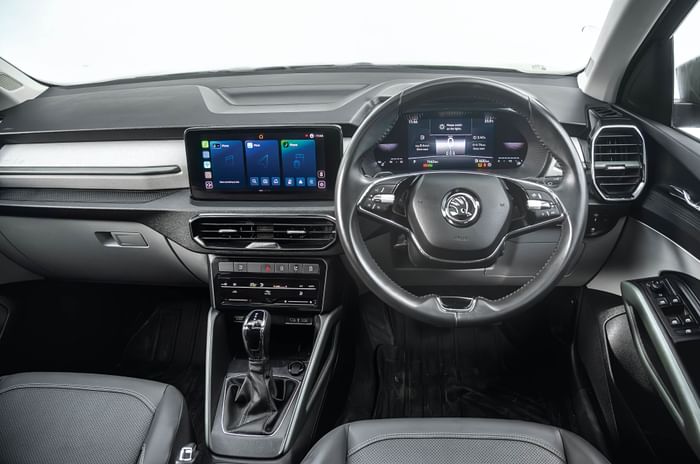
All-black theme with green trim gives Kylaq cabin a sporty vibe; quality is solid.
These two also take a different approach on the inside. The Kylaq, as expected, closely resembles the Kushaq, with shared elements like the high-quality, 2-spoke steering wheel, digital instrument cluster and touch-based panel for climate control. However, Skoda has added some flash value by giving it olive green inserts on the dashboard, door panels and centre console, along with a light-textured fascia. Overall, the design is clean and uncluttered and has a solid build, which is only furthered by the reassuring ‘thud’ you get when closing the doors.
It has a dual-tone theme, but the black upholstery can make you feel hemmed in, especially when compared to the XUV. It has a practical interior, too, with large doorbins, plenty of cubbies, and some typically Skoda ‘Simply Clever’ touches like the phone slots on the front seatbacks, a ticket holder on the windshield, and more.
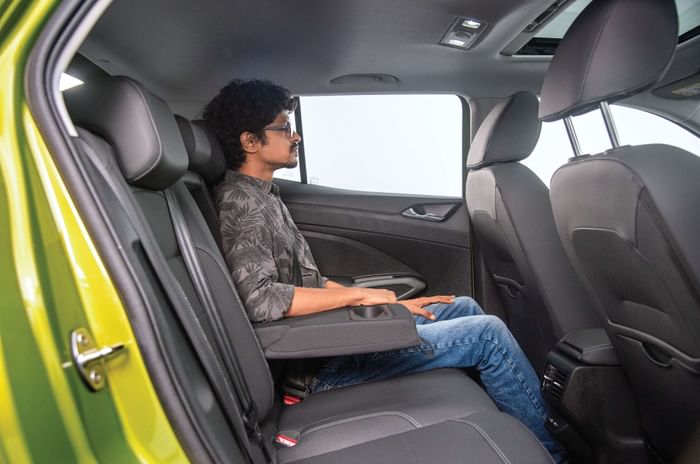
Headroom and kneeroom are decent, but it’s only wide enough for two.
The Kylaq’s front seats are better in this company, given that they offer better support and feature electric adjustment and ventilation. But in terms of the backseat, it falls behind the Mahindra. It has an adequate amount of legroom and headroom for average-sized adults, but the narrow cabin and the seat contouring mean it is best suited for two passengers. Rear occupants get their own AC vents, Type-C charging ports, adjustable headrests and a centre armrest with cupholders.
XUV 3XO cabin feels airier and more premium
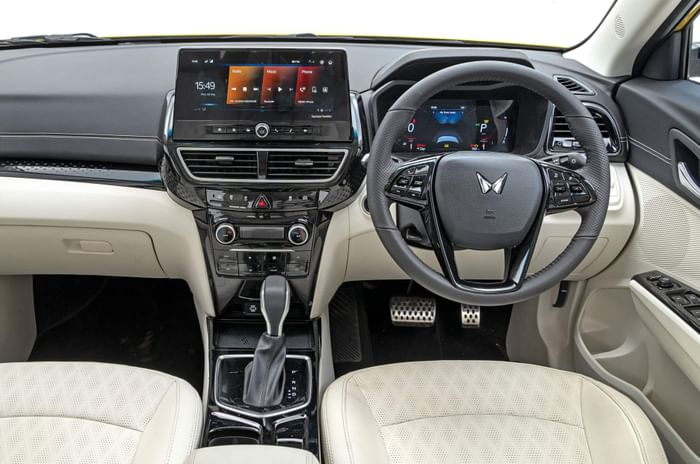
Looks and feels more premium, thanks to soft-touch materials and light upholstery.
In comparison, the XUV 3XO’s interior looks and feels more upmarket. The light-coloured upholstery uplifts the space, as does the panoramic sunroof, but the ivory seats will be challenging to keep clean. Top-spec versions get a soft-touch finish on the dash; there’s a generous use of gloss black, and elements like the steering wheel, window switches and light/wiper stalks feel top-notch. It’s also nice that the XUV gets physical buttons and knobs for the dual-zone climate control. Like the Kylaq, the 3XO has plenty of storage spaces in the cabin, with large doorbins, a good-sized cooled glove box, and more.
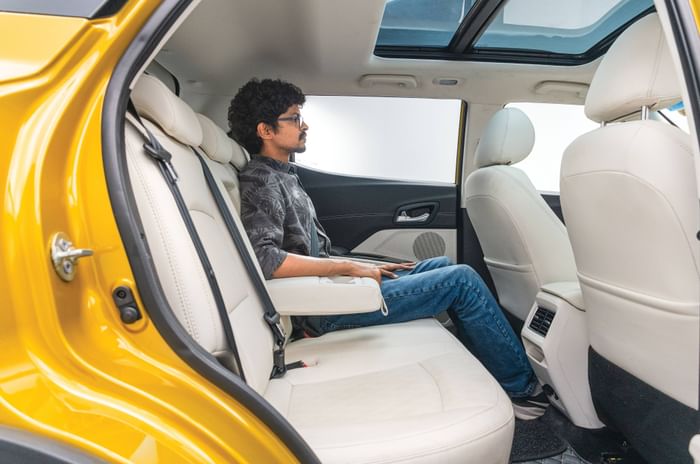
XUV 3XO’s rear seat has more room and can comfortably fit three adults.
You’ll appreciate the view you get out of the cabin from the XUV, and the bonnet flares give you the feeling that you’re driving an SUV. The front seats, even though they’re well-cushioned, aren’t as accommodating as the Kylaq’s, and you’ll also miss that you don’t get electric adjustment or ventilation. But it’s at the rear where the Mahindra has the most evident advantage. Owing to its width, three adults can sit comfortably in the XUV, and the long wheelbase means that legroom is plenty, too. If anything, accommodating the mechanism for the sunroof has eaten into headroom, but that’ll only be an issue for those taller than 6 feet. Amenities at the back include AC vents, a centre armrest with cupholders, a 12V port and a USB Type-C charger.
Skoda Kylaq vs Mahindra XUV 3XO features and safety
| Skoda Kylaq vs Mahindra XUV 3XO features and safety kit | ||
|---|---|---|
| Equipment | Kylaq | XUV 3XO |
| Keyless entry | Yes | Yes |
| Leatherette seats | Yes | Yes |
| Powered front seats | Yes | No |
| Ventilated front seats | Yes | No |
| Sunroof | Yes | Panoramic |
| Climate control | Single-zone | Dual-zone |
| Rear AC vents | Yes | Yes |
| Digital instrument cluster | 8-inch | 10.25-inch |
| Touchscreen | 10-inch | 10.25-inch |
| Android Auto/Apple CarPlay | Wireless | Wireless |
| Wireless phone charger | Yes | Yes |
| Audio system | 4 speakers + 2 tweeters | 7 speakers |
| Parking camera | Rear | 360-degree |
| Electric parking brake | No | Yes |
| Airbags | 6 | 6 |
| ADAS tech | No | Yes |
| Drive modes | No | Yes |
| Front parking sensors | No | Yes |
| Paddle shifters | Yes | No |
Speaking of amenities, both models, compared here in their top-spec forms, are very well-equipped. Common features include LED headlamps, 17-inch alloys, a sunroof, a wireless charger, a digital instrument cluster, a touchscreen infotainment system with wireless smartphone integration, leatherette upholstery, auto climate control, six airbags, traction control and ISOFIX child seat mounts. Commendably, both the Kylaq and XUV 3XO have a 5-star BNCAP rating. However, they both have features unique to them as well.
Kylaq one-ups XUV 3XO with powered and ventilated front seats
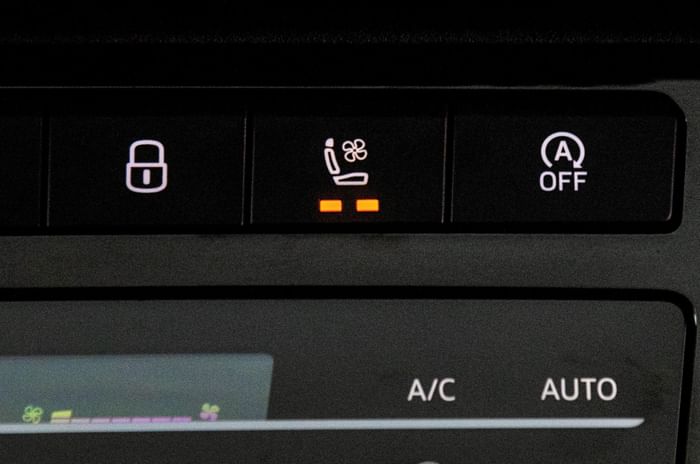
Ventilated front seats unique to the Kylaq.
The Kylaq’s front seats have ventilation and power adjustment, which the XUV lacks, and we found the output from the Skoda’s 4-speaker and 2-tweeter audio system to be more consistent. The Skoda makes do with smaller 10-inch and 8-inch screens for the infotainment and cluster, respectively. However, its screen features a newer UI compared to its stablemates, and on the whole, this system is slick and has good graphics.
XUV 3XO gets Level 2 ADAS, 360-degree camera, rear disc brakes, and more

3XO’s panoramic sunroof will be a big draw.
Coming to the XUV 3XO, the AX7 L featured here gets a larger panoramic sunroof, larger 10.25-inch screens, an electronic parking brake, a 360-degree camera, more connected tech, a 7-speaker Harman Kardon audio system, rear disc brakes, and Level 2 ADAS (blind-spot monitor, autonomous emergency braking, lane-keep assist, and more) over the Kylaq’s range-topping Prestige variant. The ADAS features work well on a clearly marked road and can be switched off completely, too, should you want to. I found the blind-spot monitor, which appears in the instrument cluster, to be particularly useful.
Skoda Kylaq vs Mahindra XUV 3XO performance and refinement
| Skoda Kylaq vs Mahindra XUV 3XO performance | ||
|---|---|---|
| Acceleration | Kylaq | XUV 3XO |
| 0-20kph (seconds) | 1.47 | 1.37 |
| 0-40kph (seconds) | 2.97 | 2.78 |
| 0-60kph (seconds) | 5.13 | 4.72 |
| 0-80kph (seconds) | 7.97 | 7.61 |
| 0-100kph (seconds) | 11.69 | 11.05 |
| 0-120kph (seconds) | 16.02 | 15.74 |
| 20-80kph (seconds) | 6.38 | 6.38 |
| 40-100kph (seconds) | 8.72 | 8.11 |
Now, on to the driving bits. Both SUVs are powered by a 3-cylinder, direct-injection, turbo-petrol engine, but they vary in displacement and output. The Kylaq has a smaller 1.0-litre unit that puts out 115hp and 178Nm, while the 3XO’s larger 1.2-litre motor produces 131hp and 230Nm. Both versions tested were paired with the same Aisin-sourced 6-speed torque converter automatic gearbox.
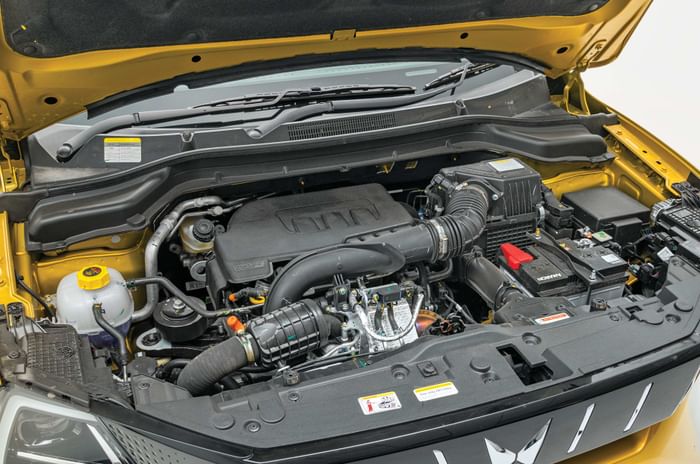
131hp 1.2L mill feels strong throughout rev range.
Given the difference in output, the Mahindra is naturally quicker in a sprint to 100kph, completing it in 11.05sec to the Kylaq’s 11.69sec. The Skoda claws back in the 20-80kph run, posting an identical time of 6.38sec, but it is marginally slower in the 40-100kph run.
Skoda 1.0 TSI feels stronger than expected
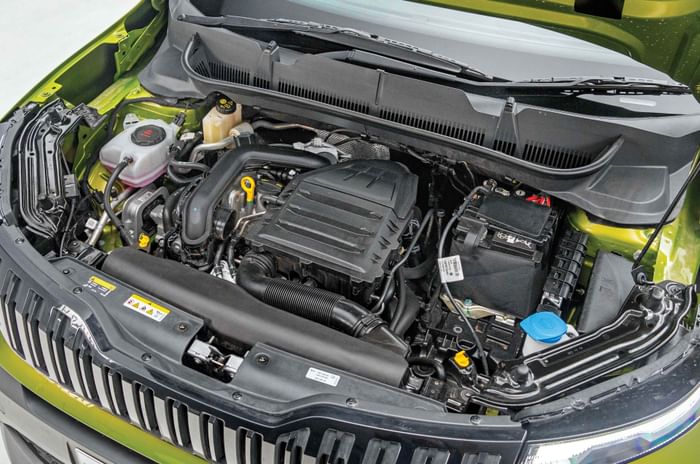
115hp 1.0 TSI engine punches above its weight.
The Kylaq’s engine is slightly slower to respond at low speeds, and that’s something you’ll have to get used to in city driving. But then on, power delivery becomes smooth and progress easy. The TSI engine punches above its weight and feels significantly stronger than its cubic capacity would have you believe. And that’s most evident in the mid-range. What helps make the most of the mid-range are the paddle shifters, which add to the engagement. And even in fully automatic mode, the gearbox does its job rather smoothly. In isolation, the Kylaq’s engine is refined, but it is the noisier unit in comparison.
XUV 3XO feels punchier at low speeds
The XUV 3XO has a significant power and torque advantage, and you feel as much from the get-go. Drive modes also help fine-tune the experience. Just as you start out, you’ll feel that the XUV 3XO is more responsive at low speeds. However, you have to be mindful – at least in city driving conditions – that it’s better in Zip mode, where power delivery is the smoothest. If you’re in Zap or Zoom mode, you will find that the engine bunches up its power quite early in the rev range. And you don’t want that when you’re in very tight moving conditions.

Modes alter response and steering weight.
Of course, when the road opens up, you’d want to switch to Zap or Zoom mode, which will have the engine breathe freer and feel different in its power delivery. While the Kylaq’s engine is the strongest in the mid-range, the XUV’s mill feels strong throughout. So, right from low revs, it’s more alert and responsive, and even in the mid-range, there is a constant and steady stream of power. You don’t have to work the engine to get the best out of it.
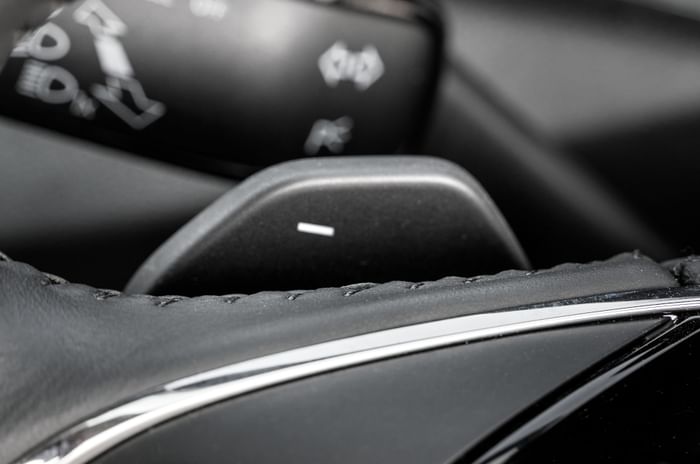
Paddle shifters add to the Kylaq’s drive experience.
The 3XO is quick and fun, but you will miss paddle shifters. Gear shifts via the lever are responsive enough, though. What’s remarkable is the Mahindra engine’s refinement. Even when revved hard, it doesn’t thrum like you’d expect a 3-cylinder unit to.
Skoda Kylaq vs Mahindra XUV 3XO fuel efficiency
XUV 3XO was more frugal in our testing

Kylaq returned a better mileage on the highway, while the XUV 3XO sipped less fuel in the city.
Coming to the important topic of fuel efficiency, we put the two cars through our test loops in Mumbai city as well as on the highway. And it’s the XUV that delivered a higher figure of 9.9kpl in town. The SUV’s auto stop/start keeps the engine off for longer durations, which could have helped the economy. The Kylaq managed 8.7kpl in the city, but it did edge past on the highway, delivering 13.3kpl to the XUV 3XO’s 13kpl figure.
| Skoda Kylaq vs Mahindra XUV 3XO fuel efficiency | ||
|---|---|---|
| Fuel efficiency | Kylaq | XUV 3XO |
| City (kpl) | 8.70 | 9.89 |
| Highway (kpl) | 13.36 | 13.01 |
Skoda Kylaq vs Mahindra XUV 3XO ride comfort and handling
Kylaq corners better, but XUV 3XO feels more stable at high speeds
Around the bends, the Kylaq feels more engaging. The Kylaq doesn’t get steering modes like the XUV 3XO, and in general, it has a lighter steering wheel, but it’s nice and smooth, and you can have great fun in the corners. You also get the feeling that this chassis could actually take on a larger, more powerful engine, maybe the 1.5 TSI for a Kylaq RS? When cruising on the highway, the Kylaq drives like a bigger car, but over undulations, there is more up-and-down movement than you get in the 3XO. And if you talk specifically in comparison to the 3XO’s ride comfort, the Kylaq is more absorbent at lower speeds, and over bumps and potholes, you’ll sense that there’s a bit more wheel travel as well.
XUV 3XO’s driving modes noticeably affect steering feel.
The XUV 3XO, too, feels fun to drive on a twisty road. Notably, its drive modes also change steering weight progressively. You get a good feeling of control at the steering wheel, but the standout element is the grip that you experience around corners. So, you can carry a lot of speed with a great deal of confidence. At higher speeds, the 3XO feels poised and composed, and you can attribute that to the relatively flatter ride than the Kylaq. On the flip side, the low-speed ride is a bit firmer than the Skoda, but not to the extent of being a dealbreaker.
Skoda Kylaq vs Mahindra XUV 3XO price and verdict
Both compact SUVs trade blows on the price front

They’re close in terms of driving experience, but the Mahindra feels like a more complete package.
In terms of pricing, the Skoda Kylaq and Mahindra XUV 3XO are about at par for comparable trim levels. The fully loaded XUV 3XO AX7 L featured here is pricey at Rs 15.79 lakh (ex-showroom, Mumbai). But forgo the ADAS, 360-degree camera and electric parking brake, and you can get the AX7, whose Rs 13.99 lakh price tag is identical to that of the top-spec Kylaq Prestige AT. Talking about like-priced variants, there is a bit of give and take in features, but they’re still close.
The duo is also close in terms of driving experience, the 3XO being marginally faster, while the Kylaq is more entertaining in its handling and slightly more absorbent in its ride quality. Where the 3XO moves ahead is in its plusher interior, more refined engine and more room for passengers. The advantage in fuel economy also tips the scales in favour of the Mahindra. Keen drivers will enjoy both models, no doubt, but it’s the XUV 3XO that eventually makes you feel like you’ve got more for your money.
Also see:
BYD Sealion 7 vs Hyundai Ioniq 5 vs BMW iX1 LWB comparison
Tata Punch CNG vs Hyundai Exter CNG: Dual duel